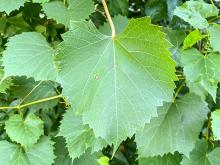Trees, Shrubs and Woody Vines
Media

Species Types
Scientific Name
Vitis species
Description
Eight species of grapes in the genus Vitis are native or naturalized in Missouri. All bear edible fruits. Like their relatives elsewhere, they have important connections to humans and to nature.
Media

Species Types
Scientific Name
Quercus spp.
Description
Oaks are the most important group of trees in Missouri, in both human and ecosystem value. They dominate most of the forests, woodlands, and savannas in the state. Learn more about our 22 species.
Media

Species Types
Scientific Name
Cercis canadensis
Description
Eastern redbud is a native shrub or small tree that is distinctly ornamental in spring with small, clustered, rose-purple flowers covering the bare branches before the leaves.
Species Types
Scientific Name
Tsuga canadensis
Description
Eastern, or Canadian hemlock is usually encountered only in landscaping in Missouri. But based on one instance in Oregon County, we know it can reproduce and spread here on its own. So if you find it on a hike, it was almost certainly planted there at some point. Look around for a cistern, old home foundation, and other persisting garden plants nearby.
Media

Species Types
Scientific Name
Juniperus virginiana
Description
By far the most common native conifer in the state, eastern red cedar is useful for its aromatic, red wood and beloved for its greenery, its resinous blue “berries,” and the spicy odor it lends the outdoors.
Media

Species Types
Scientific Name
Pinus nigra
Description
Primarily a landscaping tree, Austrian pine sometimes reproduces here on its own, and for this reason it's officially included in the flora of our state. Usually, you find it in urban and suburban ornamental plantings or, if you're out hiking, persisting at old home sites.
Media

Species Types
Scientific Name
Quercus lyrata
Description
Overcup oak is fairly easy to identify. The acorns are almost completely covered by their knobby cups. The leaves have long, narrow lobes and wide sinuses. In Missouri, it grows naturally only in wet forests along the Mississippi and Meramec rivers.
Media

Species Types
Scientific Name
Quercus alba
Description
Found throughout Missouri and in all kinds of habitats, the white oak is one of our most attractive, long-lived, and stately shade trees. Learn to recognize it by its light gray bark, rounded-lobed leaves, and distinctive acorns.
Media

Species Types
Scientific Name
Sassafras albidum
Description
Sassafras, with its aromatic oval, mitten- , and trident-shaped leaves, is rich in both human and natural history, and it can be a spectacular tree for fall color.
Media

Species Types
Scientific Name
Quercus macrocarpa
Description
Bur oaks can live for hundreds of years and become giants; many have legendary or historic status. As with most oak species, it can be identified by leaf shape.
See Also
About Trees, Shrubs and Woody Vines in Missouri
There are no sharp dividing lines between trees, shrubs, and woody vines, or even between woody and nonwoody plants. “Wood” is a type of tissue made of cellulose and lignin that many plants develop as they mature — whether they are “woody” or not. Trees are woody plants over 13 feet tall with a single trunk. Shrubs are less than 13 feet tall, with multiple stems. Vines require support or else sprawl over the ground.





















